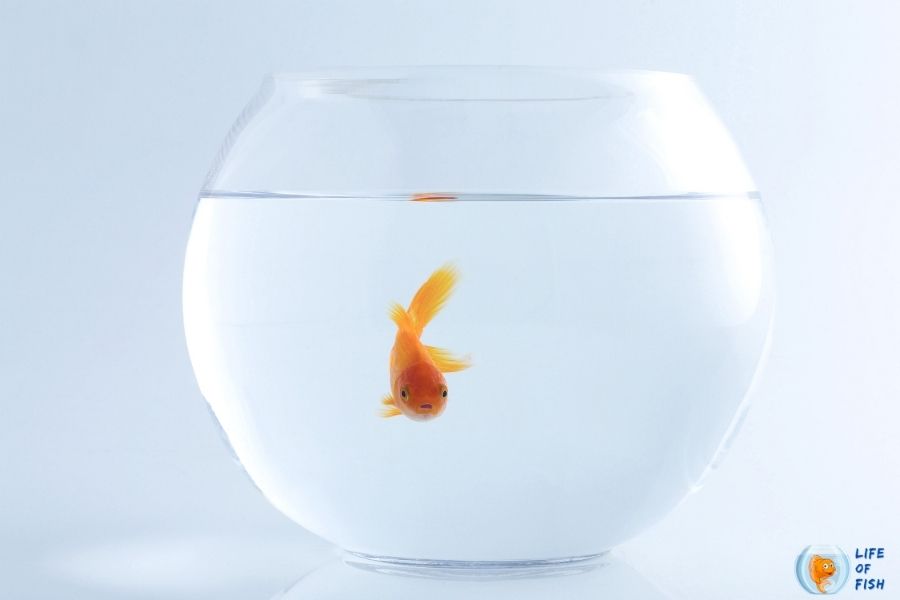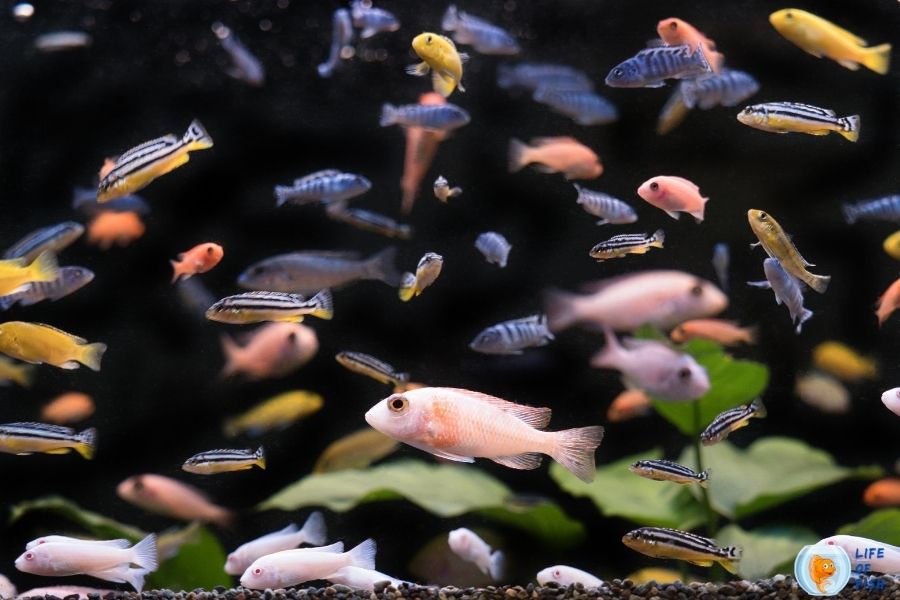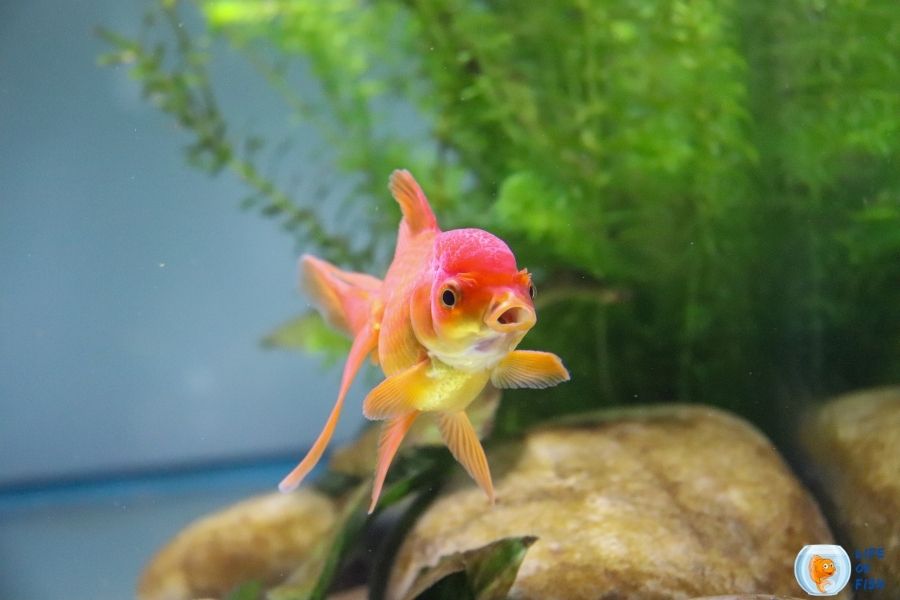Fish exhibit many behaviors when they are not happy in their surroundings. Fish keep swimming into the glass is one of these behaviors. There are many reasons for the question “ why do my fish Keep Swimming Into The Glass?”, and we will discuss them one by one.

Why do my fish keep swimming into the glass?
Jump To
A happy fish will have its fins spread out and swim around the aquarium confidently.
A fish that is not happy will tend to hide away and stay close to the glass, the bottom, the caves, decorations, or the plants.
If your fish is swimming into the glass, it may be trying to escape the aquarium. They exhibit this behavior mainly because of stress.
There are several reasons why fish may swim into the glass (causes of stress):
Poor water conditions
Fish require clean water to thrive. Ammonia, nitrites, and nitrates are toxic to your fish and can cause stress.
If the levels of these toxins are high, fish will start to exhibit stress behaviors like swimming into the glass.
Behavior change is the least that can happen to your fish when exposed to ammonia, nitrites, or nitrates. If the levels are high enough, your fish may have trouble breathing, become lethargic, and eventually die.
You should do a weekly water change of at least 25% to avoid this. This will help to keep the water clean and the levels of toxins low. You should also test your tank’s water regularly to ensure the levels are within the safe range.
If you are unsure how to test the water, you can take a sample to your local pet store, and they will test it for you.
Overcrowding
If you have too many fish in your aquarium, it can cause stress. This is because the fish do not have enough space to swim around, and they may start to fight with each other. This can cause injury and even death.
Further, overcrowding can result in Ammonia spikes as the fish produce more waste. This can cause the water quality to decline very quickly, leading to stress in the fish.
You should only put as many fish in your aquarium as the filter can handle to avoid this. A good rule of thumb is one small fish per gallon (4 L).
Additionally, you should also have a good filtration system in place to keep the water clean. A canister filter is a good option for larger aquariums with more fish.
Lack of hiding places
If there are no hiding places in your aquarium, the fish may feel exposed and vulnerable. Lack of hiding places can lead to stress, which can cause the fish to swim into the glass.
This often happens to shy fish species like bettas. You can add some plants or decorations to the aquarium to provide them with some relief. This will provide the fish somewhere to hide when they feel stressed.
Overfeeding
If you are overfeeding your pet fish, it can cause stress. This is because the fish will produce more waste, leading to poor water quality. Additionally, the leftover food will start to rot, leading to Ammonia spikes.
To avoid this, you should only feed your fish as much as they can eat in 2 minutes. Any more than that, and you are overfeeding them.
You should also remove any uneaten food from the aquarium so that it does not decompose and pollute the water.
Incompatible tank size
Different fish require different tank sizes. If you have a fish that requires a large tank and you are keeping it in a small tank, it will be stressed.
This is because the fish will not have enough space to swim around, and it may start to exhibit aggressive behaviors.
Bettas and goldfish are some species that often get mistreated by keeping them in small tanks.
To avoid this, you should research the minimum tank size requirements for the fish you want to keep. Once you have that information, you should make sure the tank you are using is at least that size.
Aggressive tankmates
If you plan to have a community fish tank, choosing peaceful fish species that will not harass or attack other fish is essential.
If you do not, the aggressive fish will stress out the other fish and may even injure or kill them. When fish get bullied by aggressive tankmates, they may get stressed and start to swim into the glass.
To avoid this, you should research the fish species you want to keep. Make sure they are compatible with each other and will not fight.
Further, some fish species prefer to stay alone while others do very well in groups. So, ensure you are keeping the fish in the conditions they prefer.

How to stop fish from glass surfing?
Since your fish already keep swimming into the glass, you should find a way to stop this out-of-the-ordinary behavior.
To stop your fish from glass surfing, you should calm down your stressed fish. Different causes of stress have different solutions. But there are some general methods you can use to calm your fish down:
How to calm down stressed fish?
Provide your fish with the right water conditions they need (temperature, pH, etc.)
If your fish is stressed because of poor water conditions, you should immediately improve the water quality.
When you observe a stressed fish in your aquarium, checking the water quality is the first and foremost thing you should do.
You can use a cheap water testing kit to test the water quality. Once you know what is wrong with the water, you can take steps to fix it.
For example, if the water is too cold, you can use a heater to raise the temperature. If the tank water is too alkaline or acidic, you can use chemicals to fix the pH levels.
If tests show increased Ammonia, Nitrate, and Nitrite levels, performing a water change is a must.
Depending on how dirty your aquarium is, you may have to change about 40% of the water to make things right.
However, you shouldn’t do massive water changes at once. The best approach is to change about 5% of the water every hour so that your fish can get acclimated to the new water conditions.
Additionally, you should also perform regular water changes to keep the water quality high.
How often you should do water changes depends on the size of your tank, fish population, and other factors. You should perform a water change of about 10-15% every week as a rule of thumb.
Add more hiding spots in the tank so the fish can feel more secure
If your fish are stressed because they feel exposed, you should add more hiding spots in your tank. This will make your fish feel more secure and less stressed.
Usually, when a fish feel exposed and vulnerable, it tries to hide somewhere. If your tank has nowhere to hide, it will try to escape the tank by keep swimming into the glass.
Even though you have social and friendly fish species in your tank, it is important to provide hiding spots. This is because all fish need a place to retreat when they feel scared or threatened.
You can add hiding spots by adding more plants, rocks, or decorations to your tank. Make sure there are plenty of hiding places for the fish to hide so they can feel secure.
Feed the fish less to reduce water pollution caused by uneaten food and debris
Some fish species are voracious eaters, while some are not. If you have fish that are not very good at eating, they may leave a lot of uneaten food in the tank, polluting the water.
On the other hand, if you have voracious eaters, they will eat like there is no other food in the world. This can also cause water pollution as their waste products will increase.
The best way to deal with this is to feed your fish in fewer amounts. Only give your fish as much food as they can eat in a few minutes. This will reduce the amount of uneaten food and also the amount of waste produced.
Additionally, you should also remove any uneaten food from the tank after a few minutes. This will further reduce the amount of water pollution caused by uneaten food.
Further, make sure that the filter is properly working so that it can remove the waste products from the water.
Do not overcrowd the tank, so the fish have more space to swim around
An overcrowded tank means more competition for food and more stress. This can cause the fish to become aggressive and also make them more susceptible to diseases.
When a fish tank holds more fish than it can support, the water quality will start to decline. This is because the waste products produced by the fish will increase, and the filter will not be able to remove all of it.
As a result, the water will become more polluted, and the fish will be under more stress. This can lead to disease and even death.
To avoid this, do not overcrowd the tank. Ensure that there is enough space for the fish to swim around comfortably.
If you already have more fish in your tank than the recommended amount, remove some of them into another tank or sell them.
Choose compatible tankmates that will not bully or harass the other fish
While having too many fish in your tank is not good, having incompatible tankmates can also be a problem. This is because some fish species are known to bully or harass other fish.
As a result, the bullied fish will be under a lot of stress, leading to disease and even death.
To avoid this, choose only compatible tankmates. Do some research on the fish species that you want to keep and make sure that they will not bully or harass the other fish.
If you observe that some of your fish are injured, there might be a bully in the tank. In this case, you should remove the bully fish from the tank.
Make sure the tank is the right size for the fish you are keeping
Every fish species have a minimum recommended tank size. This is because some fish need more space to swim around while some fish do not.
If you keep a fish in a too-small tank, it will be under a lot of stress. This can lead to disease and even death. So, do some research and check if your fish has enough space to swim around comfortably.
If the fish tank is too small for your fish, make necessary arrangements to transfer them into a larger tank.

Related Questions
Why are my fish acting weird after the water change?
The most prevalent cause of this is that the water parameters are no longer the same as they were before the water change.
This could be due to various reasons, such as using tap water instead of RO water, failing to remove all of the chlorine from the tap water, and so on. As a result, the fish will experience stress and may even die.
How long does it take for fish to adjust to water change?
The fish will need 30 minutes to an hour to acclimate to the new water parameters. They may be a little stressed during this time, but they will eventually get used to it.
What are the signs of stress in fish?
The most common signs of stress in fish are increased respiration rate, decreased appetite, hiding, and abnormal swimming behavior.
If you notice any of these signs and symptoms in your fish, then they are most likely stressed.
Final Words
Oftentimes, fish keep swimming into the glass because of stress. If you notice this abnormal behavior in your fish, make sure the stressor is removed from their surroundings.
You can do this by keeping the tank clean and not overcrowded, selecting compatible tankmates, and ensuring that the tank is the appropriate size for the fish.
You can help your fish have a happy and healthy life by doing these things.
Read Next : Fish Floating On Side But Not Dead ( 6 Ways to Treat )
